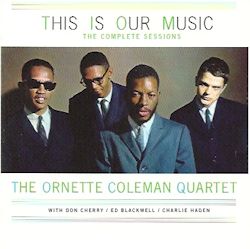CD1
1. Blues Connotation
2. Beauty Is a Rare Thing
3. Kaleidoscope
4. Embraceable You
5. Poise
6. Humpty Dumpty
7. Folk Tale
8. Little Symphony
9. The Tribes of New York
10. Rise and Shine
11. Mr and Mrs People
12. I Heard It Over the Radio
CD2
1. P. S. Unless One Has (Blues Connotation No. 2)
2. Revolving Doors
3. Brings Goodness
4. Joy of a Toy
5. To Us
6. The Fifth of Beethoven
7. Motive for its Use
8. Moon Inhabitants
9. The Legend of Bebop
10. Some Other
11. All
Ornette Coleman – Alto sax
Don Cherry – Pocket trumpet
Charlie Haden – Bass
Ed Blackwell - Drums
This is one of the albums which established a radical break from
what had previously been known as jazz. Recorded in 1960, the LP was
Ornette Coleman’s fifth album and, like his previous LPs from 1958
onwards, it introduced listeners to what became known as “free jazz”
(the title of Ornette’s sixth album). It did away with the practice
of improvising on a chord sequence and allowed musicians to play more
or less what they liked, when they liked. Charles Mingus described
free jazz as “organized disorganization, or playing wrong right”.
Although music has traditionally consisted of melody, harmony and rhythm, free jazz largely dispensed with harmony. The lack of a piano or guitar in the
line-up for this album meant that harmony was not emphasized and, indeed, is often absent altogether. In theory at least, Ornette’s interpretation of free
jazz was not always as free as many succeeding versions, since Coleman claimed to start each track with a melody – although these are often hard to
discern. These tunes are supposed to inspire the free improvisation that follows but the connection is not always obvious. For example, tracks 1, 3 and 5
on the first CD all start with a frantic theme which leads into the improvisation.
However, in a track like Little Symphony, Ornette’s solo makes better sense than some of his other solos. His solo on The Tribes of New York actually contains some melodic fragments and his solo in Some Other hints at I’m in the Mood for Love
Coleman’s methods lead to a lot of discordant atonality, which is increased by Don Cherry’s unpredictable trumpet, although the two front men often play
the introductory theme in unison or counterpoint. If anything, Cherry’s solos are more atonal than Ornette’s.
Bassist Charlie Haden - sometimes abetted by the drums – tends to maintain a solid four-four, which gives the music some stability and even swing, although
Charlie is not improvising as freely as the others. I actually prefer some of Ornette’s later recordings, where drummer Charles Moffett’s traditional style
ensured a more accessible form of free jazz.
The only jazz standard on the album is Embraceable You. It suggests another route which Ornette might have taken: improvising freely upon a
standard chord sequence without sticking rigidly to tonality. I myself have played in a band which introduced elements of free jazz into a conventional
melodic structure – and it worked well. Unfortunately, Coleman took a different path of almost total freedom. The advantage of free jazz is that it may set
the musicians free and it can force them to listen more closely to one another. Sadly, the freedom enjoyed by Ornette and his “free improv” successors
often leads to anarchy – and makes the music virtually unlistenable.
This album is not for me, although Coleman devotees will enjoy it, especially as the original seven tracks are augmented with 16. others recorded at the
same sessions
Tony Augarde
www.augardebooks.co.uk
